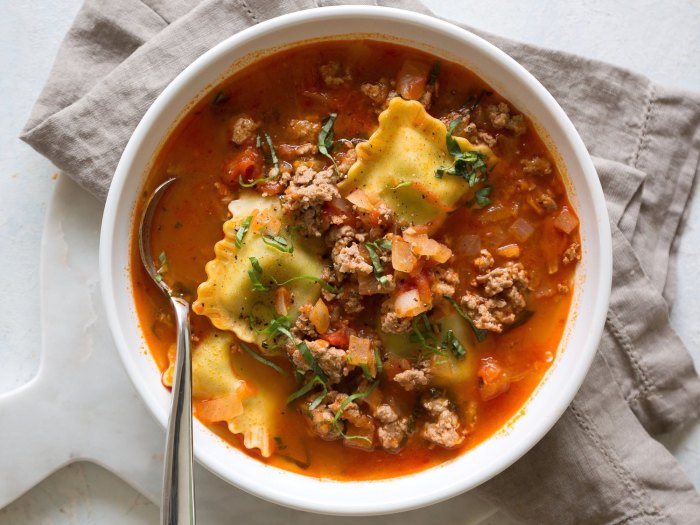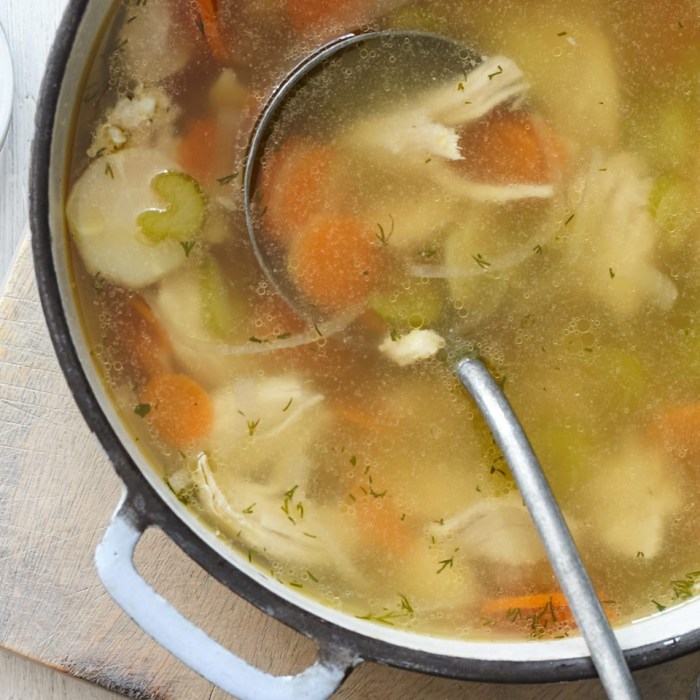Ravioli Soup Recipe Variations

Source: poshjournal.com
This section explores diverse ravioli soup recipes, highlighting variations in filling, broth, and seasonal ingredients. We’ll also delve into the nuances of using fresh versus dried ravioli and crafting a flavorful, vegetarian-friendly broth.
Ravioli Filling Variations

Source: moderndaybrownmom.com
Ravioli soup, with its comforting warmth and rich flavors, offers a delightful culinary experience. For a lighter, yet equally satisfying alternative, consider a different approach, perhaps trying a chicken and corn recipe soup which provides a refreshing change of pace. However, the hearty texture and satisfying filling of ravioli soup remains a classic choice for a cozy meal.
The heart of any ravioli soup lies in the filling. Three distinct variations showcase the versatility of this dish.
- Cheese Ravioli Soup: A classic choice, featuring a simple ricotta and Parmesan filling. The mild cheese complements the richness of the broth.
- Meat Ravioli Soup: A heartier option, using a savory filling of ground beef or pork, seasoned with herbs like parsley and oregano. This adds a substantial protein element to the soup.
- Vegetable Ravioli Soup: A lighter, vegetarian alternative. A filling of roasted butternut squash and spinach provides a sweet and earthy flavor profile.
Homemade ravioli elevates the soup significantly. Using a simple pasta dough recipe (flour, eggs, and a pinch of salt) and your chosen filling, the handmade pasta offers a unique texture and flavor unmatched by store-bought options. A seasonal vegetable ravioli soup, incorporating ingredients like asparagus, peas, or summer squash, offers a fresh and vibrant twist.
Fresh ravioli boasts a delicate texture and brighter flavor compared to dried ravioli, which tends to be slightly denser and more robust. The choice depends on personal preference and availability.
Broth Selection and Preparation

Source: amazonaws.com
The broth forms the foundation of the soup, significantly impacting its overall taste and character. Different broths offer unique flavor profiles.
A rich chicken broth is easily prepared by simmering chicken bones, vegetables (carrots, celery, onion), and herbs (bay leaf, thyme) in water for several hours. This slow cooking process extracts maximum flavor. Chicken broth lends a savory depth, vegetable broth offers a lighter, more vegetal taste, while beef broth adds a bolder, richer flavor profile. Herbs like parsley, thyme, oregano, and rosemary enhance the broth’s complexity, while spices such as black pepper, garlic powder, or even a pinch of nutmeg add subtle layers of flavor.
A vegetarian broth, ideal for vegetable ravioli soup, can be made using vegetable scraps (onion peels, carrot tops, celery leaves), mushrooms, and herbs simmered in water. Adding a touch of tomato paste adds depth and richness.
Ingredient Selection and Preparation
A classic ravioli soup recipe requires careful selection and preparation of ingredients to ensure optimal flavor and texture.
| Ingredient | Quantity | Unit | Notes |
|---|---|---|---|
| Chicken Broth | 6 | Cups | Homemade or store-bought, low sodium preferred |
| Ravioli | 1 | (1 pound) Package | Cheese, meat, or vegetable filled |
| Carrots | 2 | Medium | Diced |
| Celery | 2 | Stalks | Diced |
| Onion | 1 | Medium | Diced |
| Fresh Parsley | 1/4 | Cup | Chopped |
| Salt and Pepper | To taste | – | – |
Adding vegetables like spinach, zucchini, or mushrooms enhances the soup’s nutritional profile. Fresh herbs offer a superior flavor and aroma compared to dried herbs. To prevent sticking or breaking, gently add the ravioli to the simmering soup and avoid over-stirring.
Cooking Methods and Techniques, Ravioli soup recipe
The following steps Artikel the process of preparing a delicious ravioli soup.
- Step 1: Sauté the diced carrots, celery, and onion in olive oil until softened.
- Step 2: Add the chicken broth and bring to a simmer. Add salt and pepper to taste.
- Step 3: Gently add the ravioli to the simmering broth.
- Step 4: Simmer for 8-10 minutes, or until the ravioli is cooked through. Avoid boiling, as this can break the ravioli.
- Step 5: Stir in the fresh parsley just before serving.
Simmering, rather than boiling, ensures gentle cooking and prevents the ravioli from breaking apart. The ideal consistency is a light broth, coating the ravioli without being overly watery or thick. The cooking stages progress from a clear broth with sautéed vegetables to a simmering broth with added ravioli, culminating in a fragrant, flavorful soup with tender ravioli.
Serving Suggestions and Garnishes
Presentation and garnishes elevate the ravioli soup experience.
- Garnish 1 (Italian): Fresh basil leaves and grated Parmesan cheese.
- Garnish 2 (Spicy): A drizzle of chili oil and chopped fresh cilantro.
- Garnish 3 (Creamy): A dollop of crème fraîche and a sprinkle of black pepper.
Serve the soup hot in warmed bowls, accompanied by crusty bread for dipping. For an attractive presentation, consider adding a swirl of olive oil or a sprig of fresh herbs to the bowl. Leftover ravioli soup can be reheated gently on the stovetop or in the microwave, ensuring that it is heated through without overcooking the ravioli.
FAQ Section
Can I freeze leftover ravioli soup?
Yes, ravioli soup freezes well. Allow it to cool completely before storing in airtight containers. It can be frozen for up to 3 months.
What kind of pasta can I substitute for ravioli?
Other small pasta shapes like tortellini or small shells can be used as substitutes, though the taste and texture will differ slightly.
How can I thicken my ravioli soup?
A cornstarch slurry (cornstarch mixed with cold water) or a roux (butter and flour cooked together) can be used to thicken the soup. Add slowly while stirring constantly.
Can I use store-bought broth?
Absolutely! Store-bought chicken, vegetable, or beef broth is a convenient alternative to homemade broth.


